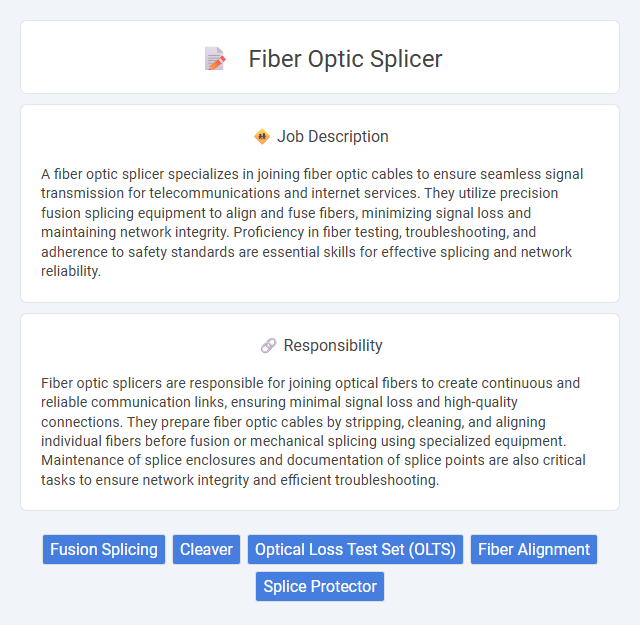
A fiber optic splicer specializes in joining fiber optic cables to ensure seamless signal transmission for telecommunications and internet services. They utilize precision fusion splicing equipment to align and fuse fibers, minimizing signal loss and maintaining network integrity. Proficiency in fiber testing, troubleshooting, and adherence to safety standards are essential skills for effective splicing and network reliability.
People with good hand-eye coordination, attention to detail, and steady hands are likely suitable for a fiber optic splicer job, as the work involves precise fusion of delicate fiber strands. Those with patience and the ability to work in confined or sometimes challenging environments may find this role more manageable. Individuals prone to discomfort in low-light or small workspaces might find this job less suitable.
Qualification
A fiber optic splicer must possess a high school diploma or equivalent, with specialized training in fiber optic cable splicing and network installation. Proficiency in using fusion splicing machines, optical time-domain reflectometers (OTDR), and understanding of fiber optic cable layouts and industry safety standards are essential. Certification from recognized bodies such as the Fiber Optic Association (FOA) enhances job prospects and validates technical expertise in splice techniques and cable repair.
Responsibility
Fiber optic splicers are responsible for joining optical fibers to create continuous and reliable communication links, ensuring minimal signal loss and high-quality connections. They prepare fiber optic cables by stripping, cleaning, and aligning individual fibers before fusion or mechanical splicing using specialized equipment. Maintenance of splice enclosures and documentation of splice points are also critical tasks to ensure network integrity and efficient troubleshooting.
Benefit
A fiber optic splicer job likely offers a high demand for skilled technicians, increasing job security and career stability. Earning potential may be favorable due to the specialized nature of the work and the growing telecommunications industry. Opportunities for career advancement and skill development are probable as technology evolves and expands across various sectors.
Challenge
Fiber optic splicer jobs likely involve intricate challenges related to aligning ultra-thin fibers with extreme precision to ensure minimal signal loss. The probability of encountering environmental factors such as weather and confined workspaces may increase the complexity of the task. Mastering the technology and maintaining steady hands could be essential to overcoming these demanding conditions efficiently.
Career Advancement
Fiber optic splicers specializing in installing, fusing, and testing fiber optic cables can advance their careers by gaining certifications such as Certified Fiber Optic Technician (CFOT) and mastering advanced splicing techniques. Experience with complex network designs and proficiency in troubleshooting fiber optic systems position splicers for senior technician, project manager, or network engineer roles. Continuous training in emerging technologies like bend-insensitive fiber and fusion splicing automation enhances career growth and earning potential in the telecommunications industry.
Key Terms
Fusion Splicing
Fusion splicing is the core technique used by fiber optic splicers to join two optical fibers end-to-end with minimal loss and reflection. This process involves precisely aligning fiber cores and using an electric arc to melt and fuse them together, ensuring optimal signal transmission in telecommunications and high-speed data networks. Mastery of fusion splicing is essential for maintaining network integrity, reducing signal attenuation, and supporting advancements in fiber optic infrastructure.
Cleaver
A fiber optic splicer specializes in joining optical fibers using precision equipment, with the cleaver playing a critical role in ensuring a clean, accurate cut for optimal signal transmission. The cleaver must deliver a flat and smooth fiber end-face, minimizing signal loss and reflection during the fusion splicing process. Mastery of cleaver operation directly impacts splice quality, network reliability, and overall fiber optic system performance.
Optical Loss Test Set (OLTS)
Fiber optic splicers rely heavily on the Optical Loss Test Set (OLTS) to measure signal attenuation and ensure optimal fiber connections. The OLTS evaluates insertion loss and return loss, providing critical data to verify splice quality and network performance. Mastery of OLTS operation is essential for precise diagnostics and maintaining fiber optic network integrity.
Fiber Alignment
Fiber optic splicers specialize in aligning and fusing optical fibers with precision to minimize signal loss and ensure high-quality data transmission. Mastery of fiber alignment techniques, including core-to-core and cladding alignment, is critical for achieving low splice loss and optimal connectivity in both single-mode and multi-mode fibers. Advanced fiber splicers utilize state-of-the-art fusion splicing machines that provide real-time alignment feedback and automatic adjustments to enhance splice accuracy and network reliability.
Splice Protector
Splice protectors are essential components in fiber optic splicer jobs, providing critical protection to fusion splices by preventing mechanical damage and environmental exposure. These protectors maintain the integrity of the fiber connection, ensuring low signal loss and optimal network performance. High-quality splice protectors enhance the durability and reliability of fiber optic installations, making them indispensable in telecommunications and data transmission projects.
 kuljobs.com
kuljobs.com